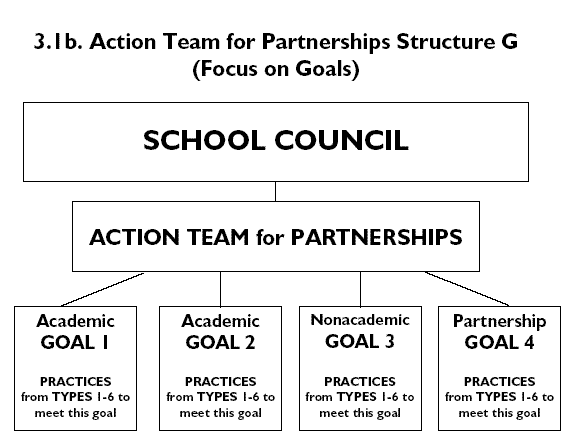Action Team for Partnerships
All schools in the National Network of Partnership Schools (NNPS) use an Action Team for Partnerships (ATP) to organize and sustain a program of school, family, and community partnerships. With an ATP, teachers, administrators, parents, community members, and others can work together to connect family and community involvement with school improvement goals. The ATP in each school aims to:
- Create a welcoming school environment for families
- Engage families and the community in ways that support student achievement and success
The ATP is the “action arm” or committee of the School Improvement Team or School Council. Although the ATP members oversee the school’s partnership program, other teachers, parents, students, administrators, and community members also may lead family and community involvement activities.
Each school’s ATP will conduct the following activities:
- Write a One-Year Action Plan for Partnerships (see ) with activities linked to selected goals in the School Improvement Plan
- Integrate all family and community involvement activities conducted by teachers and school groups in the One-Year Action Plan for Partnerships
- Recruit and recognizes other teachers, parents, community members for leadership and participation in family and community involvement activities
- Implement, coordinate, publicize, and oversee the planned involvement activities
- Monitor progress, assess the strengths and weaknesses of implemented involvement activities, document results, and resolve problems
- Report progress to the School Council (or School Improvement Team) and to the faculty, PTA/PTO, local media, and other groups
- Replace departing ATP members
- Continue improving the school’s program of family and community involvement
An ATP typically has 6 to 12 members and must include:
- The school principal
- Two or three teachers from different grade levels
- Two or three parents with children in different grade levels
- The parent liaison
- A PTA/PTO officer or representative
- Two students from different grade levels (on high school ATPs)
The ATP should also include:
- Members from the community at large, including: business partners, interfaith leaders, representatives from literary, cultural, civic, and other organizations.
- Others who are central to the school’s work with families, including: the school nurse, social worker, instructional aide, counselor, other administrator, secretary, grandparent raising a child in the school, custodian, or etc.
An Action Team for Partnerships (ATP) may be organized in one of two ways:
-
By Improvement Goal
- ATP members split into subcommittees for four school improvement goals for student success: two academic goals, one nonacademic goal, and one overall partnership goal for a welcoming school environment.

-
By Type of Involvement
- The ATP forms six subcommittees or work groups. Each subcommittee designs and oversees activities for one of the Six Types of Involvement (see ) to support student success.

The ATP meets as a whole team at least once a month to coordinate and monitor all activities. Subcommittees meet as needed to plan and implement activities in the One-Year Action Plan for Partnerships.
Any ATP member who has the respect of all other members may serve as the chair. NNPS recommends that co-chairs, often one parent and a teacher or school administrator, share leadership responsibilities. Leaders should have excellent communication skills and an understanding of the partnership approach. At least one member of the ATP also may serve on the school improvement team, school council, or other decision-making body as a “linking leader” to report plans and progress on partnerships. Co-chairs also should lead each subcommittee of the ATP.
Having a team with at least six members (or as many as twelve or more) ensures that responsibilities for leadership and conducting planned activities can be delegated so that no one is overburdened and the work of the ATP will continue even if some members move or change schools or positions.
ATP members serve renewable terms of two to three years, with replacement of any who leave in the interim. Other thoughtful variations in assignments and activities may be created by small or large schools using this process.
For many years, NNPS presented Partnership School Awards to schools and their ATPs for outstanding and continuous work on partnerships. Read about some past years’ winners here.
For more information, answers to questions about organizing an effective ATP, and tools for ATPs to conduct their work, see Chapter 3, “Taking an Action Team Approach” in the NNPS handbook: Epstein, et al. (2002), School Family, and Community Partnerships, Your Handbook for Action (2nd ed.) Thousand Oaks, CA: Corwin Press.
Copyright © 2024 - PartnershipSchools.org at the Johns Hopkins University School of Education - All rights reserved. Conforms to W3C Standard XHTML & CSS

